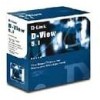D-Link DS-510S User Guide - Page 10
Introduction
 |
View all D-Link DS-510S manuals
Add to My Manuals
Save this manual to your list of manuals |
Page 10 highlights
DSL-510 ADSL Router User's Guide Chapter 1 - Introduction ADSL modem technology is a relatively new technology and may be unfamiliar to the reader. In this section, we introduce you to ADSL technology and give a brief description of its key attributes. We also give a general description of the D-Link DSL-510 ADSL Router and its main features. What is ADSL? Asymmetric Digital Subscriber Line (ADSL) is an access technology that utilizes ordinary copper telephone lines to enable high-speed digital data transmission and interactive multimedia applications for business and residential customers. Using existing phone lines avoids the need for adding expensive new cable. ADSL Routers use digital coding techniques that greatly increase the bandwidth capacity of telephone lines without interfering with regular telephone services. For the ADSL Router user, this means much faster data communications. ADSL Routers make it possible to enjoy benefits such as high-speed Internet access, telecommuting, collaborative computing, distance learning, movies on demand and multi-player video gaming without experiencing any loss of quality or disruption of voice/fax telephone capabilities. ADSL provides a dedicated service over a single telephone line operating at speeds of up to 8 Mbps downstream (to the user) and up to 640 Kbps upstream, depending on the type of service and local telephone line conditions. These conditions are ideal for many user applications. A secure point-topoint connection is established between the user and the central office of the local telephone company. The user is always connected, thus eliminating dial-up time and simplifying connectivity issues. D-Link ADSL devices incorporate the recommendations of the ADSL Forum (www.adsl.com) regarding framing, data format, and upper layer protocols. Router Description and Operation The DSL-510 ADSL Router is designed to provide a simple, cost-effective and secure ADSL Internet connection for your small to medium-sized private network. The ADSL connection technology enables many interactive multi-media applications such as video conferencing and collaborative computing. The Router is easy to install and use. The DSL-510 connects to an Ethernet LAN or single computer via a standard Ethernet interface. The ADSL connection is made using ordinary twisted-pair telephone line with standard RJ-11 connectors. Product Features The D-Link DSL-510 ADSL Router provides the following features: • Data rates up to 8 Mbps for downstream and 1M bps for upstream • Friendly web-based graphical user interface for configuration and management • Supports up to eight simultaneous virtual connections for a single ADSL account • Supports T1.413 issue 2, G.dmt and G.lite standards • Auto-handshake and rate adaptation for different ADSL flavors • Widest range of DSLAM interoperability • Bridge IP over ATM LLCSNAP (RFC 1483) • Built-in MIBs for SNMP management • Upgradeable firmware through HTTP 1















